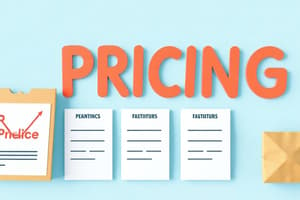Podcast
Questions and Answers
What does product line pricing primarily consider?
What does product line pricing primarily consider?
- Sales growth and production costs
- Discount practices applied to various products
- Seasonal demand fluctuations
- Cost differences, customer evaluations, and competitor prices (correct)
What is a characteristic of captive-product pricing?
What is a characteristic of captive-product pricing?
- It is used only for luxury items.
- It refers to services combining fixed and variable fees. (correct)
- It only applies to digital products.
- It involves products that may be used independently.
How does segmented pricing operate?
How does segmented pricing operate?
- It offers products at various prices regardless of differences in cost. (correct)
- It focuses on customer loyalty rewards.
- It requires a minimum quantity purchase to activate discounts.
- It bases price differences strictly on the production cost.
What is the main goal of by-product pricing?
What is the main goal of by-product pricing?
Which of the following is an example of discount pricing?
Which of the following is an example of discount pricing?
What is a characteristic of everyday low pricing (EDLP)?
What is a characteristic of everyday low pricing (EDLP)?
Which type of pricing involves adding features to justify higher prices?
Which type of pricing involves adding features to justify higher prices?
What determines the upper limit of pricing according to customer perceptions?
What determines the upper limit of pricing according to customer perceptions?
What typifies cost-based pricing?
What typifies cost-based pricing?
Which statement is true regarding fixed costs?
Which statement is true regarding fixed costs?
What is the sum of fixed and variable costs for a production level referred to as?
What is the sum of fixed and variable costs for a production level referred to as?
What essential factor influences the lower limit for pricing?
What essential factor influences the lower limit for pricing?
High-low pricing strategy is characterized by what?
High-low pricing strategy is characterized by what?
What is the primary goal of target costing?
What is the primary goal of target costing?
Which factor is NOT considered an organizational consideration in pricing decisions?
Which factor is NOT considered an organizational consideration in pricing decisions?
Before setting prices, marketers must understand which relationship?
Before setting prices, marketers must understand which relationship?
What is a key characteristic of market-skimming pricing?
What is a key characteristic of market-skimming pricing?
What does market-penetration pricing aim to achieve?
What does market-penetration pricing aim to achieve?
Which factor should NOT be a concern for market-skimming pricing strategy?
Which factor should NOT be a concern for market-skimming pricing strategy?
Which aspect is NOT typically evaluated in competitor pricing strategies?
Which aspect is NOT typically evaluated in competitor pricing strategies?
What is an important condition for the success of market-skimming pricing?
What is an important condition for the success of market-skimming pricing?
What primary factor does value-based pricing depend on?
What primary factor does value-based pricing depend on?
Which pricing strategy focuses on providing a balance of quality and price?
Which pricing strategy focuses on providing a balance of quality and price?
What is the main difference between value-based pricing and cost-based pricing?
What is the main difference between value-based pricing and cost-based pricing?
Which element of the marketing mix is unique in its ability to generate revenue?
Which element of the marketing mix is unique in its ability to generate revenue?
What does good-value pricing involve?
What does good-value pricing involve?
In which pricing strategy is the marketing program developed after the price is set?
In which pricing strategy is the marketing program developed after the price is set?
Which of the following is NOT a type of value-based pricing?
Which of the following is NOT a type of value-based pricing?
What is one reason pricing decisions are complex?
What is one reason pricing decisions are complex?
What is a requirement for segmented pricing to be effective?
What is a requirement for segmented pricing to be effective?
What characterizes psychological pricing?
What characterizes psychological pricing?
What is an example of promotional pricing?
What is an example of promotional pricing?
What can be a risk of using promotional pricing too frequently?
What can be a risk of using promotional pricing too frequently?
Which type of pricing is used for customers in different geographic locations?
Which type of pricing is used for customers in different geographic locations?
What does FOB-origin pricing imply?
What does FOB-origin pricing imply?
What is not a method of geographical pricing?
What is not a method of geographical pricing?
Which of the following describes zone pricing?
Which of the following describes zone pricing?
What does zone pricing entail?
What does zone pricing entail?
What is the key characteristic of dynamic pricing?
What is the key characteristic of dynamic pricing?
Which factor does not directly influence international pricing?
Which factor does not directly influence international pricing?
Under what conditions do competitors typically react to pricing changes?
Under what conditions do competitors typically react to pricing changes?
What does freight-absorption pricing involve?
What does freight-absorption pricing involve?
What is a common question asked when responding to price changes?
What is a common question asked when responding to price changes?
Which scenario is NOT likely to provoke a competitor's reaction?
Which scenario is NOT likely to provoke a competitor's reaction?
What is the primary purpose of basing-point pricing?
What is the primary purpose of basing-point pricing?
Flashcards
Price
Price
The amount of money customers pay for a product or service, encompassing all values exchanged for its benefits.
Customer-Oriented Pricing
Customer-Oriented Pricing
Pricing strategy focused on understanding the value consumers perceive in a product and setting a price to capture that value.
Value-Based Pricing
Value-Based Pricing
A pricing strategy where the price is set based on the perceived value of the product to the customer, not the seller's cost.
Good-Value Pricing
Good-Value Pricing
Signup and view all the flashcards
Value-Added Pricing
Value-Added Pricing
Signup and view all the flashcards
Cost-Based Pricing
Cost-Based Pricing
Signup and view all the flashcards
Penetration Pricing (New Product)
Penetration Pricing (New Product)
Signup and view all the flashcards
Premium Pricing (New Product)
Premium Pricing (New Product)
Signup and view all the flashcards
Everyday Low Pricing (EDLP)
Everyday Low Pricing (EDLP)
Signup and view all the flashcards
High-Low Pricing
High-Low Pricing
Signup and view all the flashcards
Fixed Costs
Fixed Costs
Signup and view all the flashcards
Variable Costs
Variable Costs
Signup and view all the flashcards
Total Cost
Total Cost
Signup and view all the flashcards
Average Cost
Average Cost
Signup and view all the flashcards
Target Costing
Target Costing
Signup and view all the flashcards
Price-Demand Relationship
Price-Demand Relationship
Signup and view all the flashcards
Price Elasticity of Demand
Price Elasticity of Demand
Signup and view all the flashcards
Competitor Analysis for Pricing
Competitor Analysis for Pricing
Signup and view all the flashcards
Market-Skimming Pricing
Market-Skimming Pricing
Signup and view all the flashcards
Market-Penetration Pricing
Market-Penetration Pricing
Signup and view all the flashcards
Organizational Pricing Roles
Organizational Pricing Roles
Signup and view all the flashcards
External Factors Affecting Pricing
External Factors Affecting Pricing
Signup and view all the flashcards
Product Line Pricing
Product Line Pricing
Signup and view all the flashcards
Optional-Product Pricing
Optional-Product Pricing
Signup and view all the flashcards
Captive-Product Pricing
Captive-Product Pricing
Signup and view all the flashcards
Product Bundle Pricing
Product Bundle Pricing
Signup and view all the flashcards
By-Product Pricing
By-Product Pricing
Signup and view all the flashcards
Psychological Pricing
Psychological Pricing
Signup and view all the flashcards
Reference Prices
Reference Prices
Signup and view all the flashcards
Promotional Pricing
Promotional Pricing
Signup and view all the flashcards
Risks of Promotional Pricing
Risks of Promotional Pricing
Signup and view all the flashcards
Geographic Pricing
Geographic Pricing
Signup and view all the flashcards
FOB-Origin Pricing
FOB-Origin Pricing
Signup and view all the flashcards
Uniform Delivered Pricing
Uniform Delivered Pricing
Signup and view all the flashcards
Zone pricing
Zone pricing
Signup and view all the flashcards
Basing-point pricing
Basing-point pricing
Signup and view all the flashcards
Freight-absorption pricing
Freight-absorption pricing
Signup and view all the flashcards
Dynamic pricing
Dynamic pricing
Signup and view all the flashcards
International pricing
International pricing
Signup and view all the flashcards
Competitor reactions to price changes
Competitor reactions to price changes
Signup and view all the flashcards
Responding to price changes
Responding to price changes
Signup and view all the flashcards
Questions to consider when responding to price changes
Questions to consider when responding to price changes
Signup and view all the flashcards
Study Notes
Chapter 10: Pricing
- Pricing is the amount of money charged for a product or service
- It's the sum of all values that consumers give up
- The only element in the marketing mix that produces revenue
- All other elements represent costs
Chapter Learning Outcomes
- What is a price?
- Customer perceptions of value
- Company and product costs
- Other internal and external considerations affecting price decisions
- New product pricing strategies
- Product mix pricing strategies
- Price-adjustment strategies
- Price changes
What Is a Price?
- Price is the amount of money charged for a product or service
- It represents the sum of all values that consumers give up
- to gain the benefits of having or using the product or service
- The only element in the marketing mix that produces revenue
- Unlike other marketing mix elements, price is not just a cost; it is also a driver of revenue
Factors to Consider When Setting Prices
- Customer perceptions of value (price ceiling, no demand above this price)
- Internal and external considerations (marketing strategy, objectives, nature of the market, competitors strategies and prices)
- Product costs (price floor, no profits below this price)
Customer Perceptions of Value
- Customer-oriented pricing: understanding how much value consumers place on product benefits, setting a price capturing that value
- Value-based pricing: uses buyers' perceptions of value, not seller's cost, as the key
- Types: Good-Value Pricing, Value-Added Pricing
- Cost-based pricing: product driven
Value-Based Pricing
- Value-based pricing uses the buyers' perceptions of value, not the sellers' cost, as the key
- Price is considered before the marketing program is set
- Value-based pricing is customer driven
- Types of value-based pricing: Good-Value Pricing, Value-Added Pricing
- Cost-based pricing is product driven
Customer Perceptions of Value
- Good-value pricing: offering right combination of quality and good service to a fair price
- Value-added pricing: attaching value-added features/services to differentiate offers, support higher prices, and build pricing power
Customer Perceptions of Value
- Everyday low pricing (EDLP): charging a constant every-day low price with few or no temporary discounts.
- High-low pricing: charging higher prices on an everyday basis, with frequent promotions to lower prices temporarily on selected items
Value-Added Pricing
- Unique restaurants
- Brand-name drugs
- Trendy fashions
- Sports equipment
- High-quality food
- Pricing power: ability to escape price competition and justify higher prices/margins without losing market share
Company and Product Costs
- Cost-based pricing: involves setting prices based on the costs of producing, distributing, and selling a product, plus a fair rate of return for effort and risk
- Adds a standard markup to the cost of the product
Types of Costs
- Fixed costs: do not vary with production or sales levels (Rent, Heat, Interest, Executive salaries)
- Variable costs: vary with the level of production (Packaging, Raw materials)
- Total costs: sum of fixed and variable costs
- Average cost: cost associated with a given level of output
Other Internal and External Considerations Affecting Price Decisions
- Customer perceptions of value: set the upper limit for prices
- Costs: set the lower limit
- Companies must consider internal and external factors when setting prices
- Overall Marketing Strategy, Objectives, and Mix
- Target costing: starts with an ideal selling price based on consumer value considerations and then targets costs that will ensure that the price is met
- Organizational considerations: Who should set the price? Who can influence prices?
- The Market and Demand
Other Internal and External Considerations Affecting Price Decisions
- Before setting prices, marketers must understand the relationship between price and demand for their products.
- Pricing in Different Types of Markets
- Analyzing the Price-Demand Relationship
- Price Elasticity of Demand
- Competitors' Strategies and Prices: Comparison of offering in terms of customer value; Strength of competitors; Competition pricing strategies; Customer price sensitivity
- Other External Factors: Economic conditions; Reseller's response to price; Government; Social concerns
New-Product Pricing Strategies
- Market Skimming Pricing: high initial prices to skim revenue from the market.
- Product quality and image must support the price.
- Buyers must want the product at the price.
- Costs of producing the product in small volume should not cancel the advantage of higher prices.
- Competitors should not enter the market easily.
New-Product Pricing Strategies
- Market Penetration Pricing: low initial price to penetrate the market quickly and attract a large number of buyers quickly to gain market share.
- Price sensitive market.
- Inverse relationship of production and distribution cost to sales growth.
- Low prices must keep competition out of the market
Product Mix Pricing Strategies
- Product line pricing
- Optional-product pricing
- Captive-product pricing
- Product bundle pricing
- By-product pricing
Price-Adjustment Strategies
- Discount and allowance pricing
- Segmented pricing
- Psychological pricing
- Promotional pricing
- Geographic pricing
- Dynamic pricing
- International pricing
Price Changes
- Initiating Pricing Changes: Price cuts (excess capacity, increasing market share); Price Increases (cost inflation, increased demand, lack of supply)
- Buyer Reactions to Pricing Changes: price increases (product is "hot," company greed); price cuts (new models available, models not selling well, quality issues)
- Competitor Reactions to Pricing Changes
- Responding to Price Changes: Reduce price to match competition; Maintain price but raise the perceived value; Improve quality and increase price; Launch a lower-price "fighting" brand
Studying That Suits You
Use AI to generate personalized quizzes and flashcards to suit your learning preferences.




